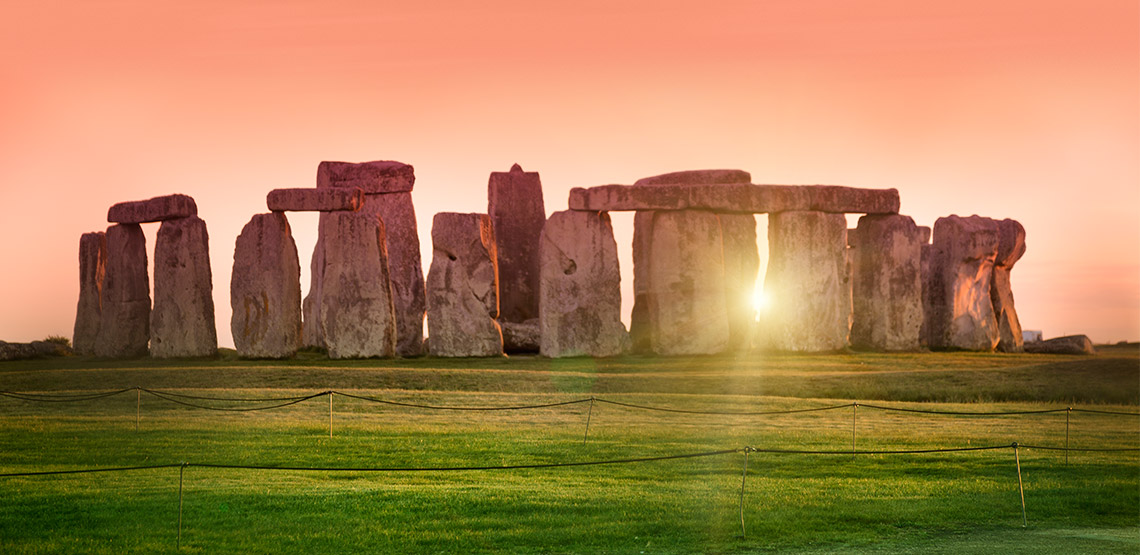Walk in Ancient Footsteps When Visiting Stonehenge
Explore the Mysterious Stones for Yourself
The prehistoric stone monument known as Stonehenge draws visitors from across the globe to see this mystifying ancient wonder. The massive standing stones arranged in a circle were constructed over several phases, between 3,000 and 2,200 BC.
While it’s unknown exactly what its purpose was — perhaps a burial ground, astronomical clock or religious temple — it is known that the massive 40-tonne rocks were dragged through the desolate plain some 30 miles to get to this location at Salisbury Hill. While not all of the original stones are still standing, over half of the 30 upright pillars are still in place.
What to Know Before You Go
Stonehenge is one of the world’s most enchanting places to visit, and something that’s on many a traveler’s bucket list. Some 875,000 people visit on average each year, which means the key to a pleasant, memorable visit is to do a little planning ahead by purchasing your Stonehenge tickets in advance. If you don’t, you could end up very disappointed as you won’t be guaranteed entrance.
A timed ticket system allows you to purchase your tickets from multiple online sellers, currently for a little over $20 USD per adult and $12 USD per child, ages five through 15. This provides you with a 30-minute scheduled slot, shuttle bus transportation from the visitor center to the stones, which are over a mile away, and access to the exhibition, the “Stonehenge Collection.”
Getting There
Fly into either Heathrow International Airport (70 minutes away) or Gatwick International Airport (90 minutes away). The cathedral city of Salisbury is a convenient place to base your stay as it’s less than a 20-minute drive, making it easy to visit Stonehenge by car.
Alternatively, you can take the train, though the closest stop to Stonehenge is Salisbury, which is 9.5 miles away. From there you’ll need to take a taxi or bus. Buses also leave from London’s Victoria Coach Station and Heathrow Airport, which will take you to Amesbury, 2 miles from Stonehenge, which is easily walkable, or you can take another bus or cab.
From natural attractions to historic sites to kid-friendly museums, these are some of the best things to do in Atlanta. Which will you visit?
Tours
Stonehenge tours are another option for viewing the magnificent stones. You can book a tour that leaves from Salisbury or London, with multiple options available from a range of operators. Most include visits to other sites too, with an hour or so at Stonehenge, and then perhaps a trip to Windsor Castle, Salisbury and Bath.
There are also special access tours that will take you up close to the stones, something you can’t do with a regular visit or tour. But you’ll have to book well in advance as there are few seats available for this rare experience.
If you want to treat yourself, you can even take a private chauffeur-driven tour, riding in a Rolls Royce, a BMW or another type of luxury vehicle. These customized tours may include special access to the stones, trips to other historic sites, villages, gardens and pubs.
Best Time of Day to Visit
June through September are England’s warmest months, and the most popular time for visitors to arrive, so if you come during the summer season, aim to visit very early, just as it opens as the buses don’t arrive until mid-morning. Or visit toward the end of the day — the site is open until 7:00 p.m.
An hour before dusk in the winter may be the very best time, when you can catch the sun going down behind the stones. While a winter or summer solstice visit is sure to be unforgettable, and entrance is free, that also means bumping elbows with tens of thousands of others.
Nearby Attractions
Visiting Stonehenge puts you within just an hour’s drive of many other historic sites, including the town of Bath, where you can bathe in naturally hot, mineral-rich spa waters just like the Romans did, New Forest National Park and more.
One of the reasons Stonehenge is one of the best places to visit in the UK is because it’s located so close to other attractions. In Salisbury you can see Old Sarum, the site of the original city which has shown evidence of habitation from 3,000 BC, and Salisbury Cathedral, which has the highest spire in England at over 400 feet high and was constructed in the 13th century.









